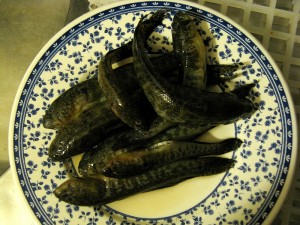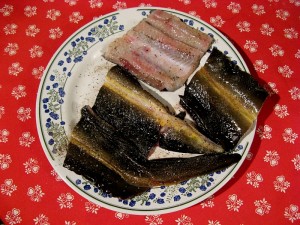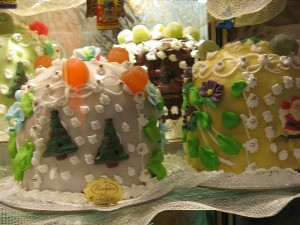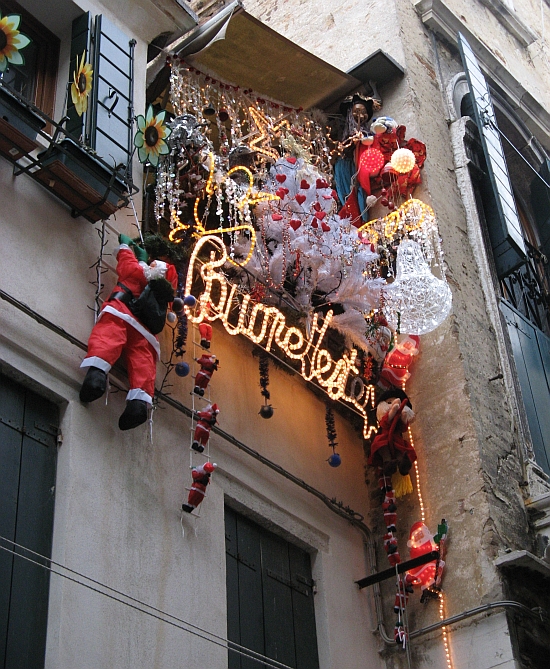Here the holiday season breaks down roughly into three categories: Food, Religion, and Santa. (I include “presents” under “Santa,” unless you’re giving somebody gold, frankincense, and/or myrrh.) I can’t think of any component which wouldn’t fit in at least one of those columns.

My impression is that the adults respond to the first, children to the third, and somewhere in there religion jostles to find a place, as if it were stuck inside a vaporetto churning toward December 25 and can’t manage to get off at the right stop because everybody is blocking the aisle with their strollers, shopping carts, enormous bags, and equally enormous selves. Yes, it’s a project here, as in many places, to feel that Christmas is anything other than a big blobby holiday everybody loves or hates for their own reasons.
This is not to say that people don’t acknowledge any religious aspect of the day — they do. By the admission of many, it’s one of the few times a year that they pass through the church doors. And virtually every church boasts its own Nativity scene, many of which are appealingly homemade. I don’t know if the big mega-shopping centers on the mainland display the Nativity in any form other than in a box with a price tag — I have never gone over there before the holidays and I don’t feel like risking what remains of my equilibrium by trying it.
But if I’ve never gone, why do I assume it’s bedlam? Two words which apply to life on the mainland: Kids and cars.
Here is our order of march for the festive three days (yes, we get a bonus, thanks to St. Stephen).
Buy groceries/send cards/clean and decorate hovel. Seeing that we have no space for anything larger than a paper clip, we skip the tree. I drape some festoons around the heavy forcola made for rowing in the stern of a balotina. I call it the Christmas Forcola and I really like it. And after all, it was a tree once.
The first year I did this, Lino regarded it as a possibly ominous sign of an incurable urge Americans are known to have to come up with impulsive, unorthodox, possibly unnecessary, vaguely embarrassing stunts. These are generically called americanate (ah-mer-i-cahn-AH-teh). Americanate of any sort fly in the face of The Way We’ve Always Done It and are sure to draw more ridicule than appreciation. Even if you commit one of these acts in the privacy of your own home, your Italian consort will still feel that the Natural Order of Things has been disagreeably disturbed. I learned early on that they’re not worth it. But the Christmas Forcola stays.
Christmas Eve: Big dinner. It is always based on fish, and more precisely, in the manner of Venetian families since the Bronze Age, the menu is this:
Antipasto — anything you like and can afford, which in our case rules out baccala’ in most forms but does allow space for smoked herring, anchovies, and some Ukrainian caviar we were given.

First course: Risotto of go‘. You may remember we scored a small trap for snaring these lagoon fish, but we’ve also fished for them by looking for their lairs and then inserting an arm (Lino’s arm, I’ll admit) down into it till the fish is grasped. For years the go’ was one of the many humble and abundant fish on which families relied, and was consequently very cheap. In that era, sea bass and bream were elite creatures which cost three times what you’d pay for go’. Now the situation is reversed: Thanks to fish farms, bass and bream are sold at fire-sale prices (7 euros a kilo, or $5 per pound), and go’ now costs 18 euros a kilo ($12 a pound). Lino can’t get over it.
Anyway, risotto of go’ is a profoundly Venetian dish, so profound that you hardly ever find it on restaurant menus. The memory of this comestible has almost disappeared under the onslaught of Norwegian salmon and French turbot.
Second course: Roasted eel. You could also simmer your pieces of eel in tomato sauce, but throwing chunks of this creature on the griddle and then opening all the windows to let out the smoke from its burning fat is part of Christmas. It is extremely delectable and I have come to count on it as part of the holiday tastefest.

And I realize how blessed we are to be able to eat it, considering that Lino remembers there were people, when he was a lad (and for centuries before, probably), who were so poor that they would go to the fish market on Christmas Eve and ask the vendors for the offal — the heads and innards of the eels — to have something to make their risotto with. I did not make that up and neither did he.
Yes, you can have bass or bream or canned tuna or whatever else you might prefer. But eel is the Ur-fish for Christmas Eve. Just for the record.
Then we eat some pieces of Parmigiano-Reggiano cheese, which is the perfect antidote to the fish taste lingering in your mouth. (Actually, we eat its humbler cousin, a cheese called grana padano. Sorry, but it’s just as good.)

Then some radicchio from Treviso, either chopped as a salad or grilled on the stove. The bitterness perfectly offsets the cheese flavor lingering in your mouth.
Yes, it’s all been figured out and would be very hard to improve on, in my view.
Then there’s a free-for-all involving nuts, fruit, and nougat (soft? hard? with almonds? peanuts? it’s up to you). And if you like — and I certainly do — a few spoonfuls of mostarda, which comes in various styles but which is essentially applesauce that has been debauched by the sharpest mustard imaginable, studded with pieces of candied, flaming-flavored fruit. If you remember Red-Hots, you only have to imagine them as nuggets of fruit.
This, and opening the presents, gets you to the verge of midnight, and it’s off to mass. They tend not to do pageants, but there is a smattering of Christmas songs which tag the event as festive. You wouldn’t know it by the songs themselves; if you hadn’t been informed that it’s Christmas, the music would lead you to suppose that the ritual was something between Ash Wednesday and the Day of the Dead.
I will resist the temptation to express my views on how the glorious traditions of music have deteriorated in the old Belpaese; I’ll just say not to expect to be hearing soaring cantatas or any of the sublime compositions with which the great masters, many of them Italian, blessed the world. If you think of church music here nowadays, at least at the parish level, you must imagine peeling plaster set to two guitars and a piano played by someone who hasn’t yet taken his second lesson.
The congregation does sing “Adeste Fidelis” and “Silent Night,” but in the most lugubrious way possible. If it were any more lugubrious, the singing would come to a complete stop. There is also a special Christmas song (undoubtedly there are more, but it’s the only one I hear around here) called “Tu scendi dalle stelle“ (You came down from the stars) which in its sincerity and simplicity could really squeeze your heart. Unfortunately, this too is sung as a dirge. Happily, I have found a version which gives much more of a sense of the beauty of this little carol; the translation isn’t very good but it’s better than nothing. Meanwhile, though, I think the music will have the desired effect.
You get home past 1:00 AM but don’t think you’re headed straight to bed: First you have to eat some slabs of panettone and drink some prosecco.
Eating and drinking: What an original idea; it’s only been two hours since we hauled ourselves up from the table.
Then it’s off to bed, so we can sleep until it’s time to get up on Christmas morning. Which means going to mass (again), but this time at the basilica of San Marco, followed by MORE FOOD.
Christmas lunch! Tortellini in broth, an elixir made yesterday by simmering beef and chicken and a couple of hefty beef bones along with onion, celery and carrot. It’s going to be heavenly, I can tell just by looking at it.
For Lino as a lad, and for mostly everyone else, Christmas was food. “Who knew anything about presents?” he recalled rhetorically. “We hardly had a tree, either. At Christmas you ate — you ate things you didn’t have at any other time of year.” His mother made the pasta herself, and then the tortellini. Then came hunks of the boiled meat. In the evening, veal roast with polenta. Lest you imagine his Christmas as something Dickensian, he knew people — they lived upstairs — who didn’t have meat, period. I know some elderly Venetians who recall that the crowning moment of any holiday meal was chicken.
We will be preparing something radically different for Christmas evening (but not so radical as to qualify as an americanata): Roast pork with fennel seeds. Oddly enough, this unusual recipe got the official stamp of “Well, let’s give it a try” approval. This decision was pushed over the top by my enthusiasm for roast pork, which I think he may never have tasted. I hope my memories have not deceived me, as they so often do.

But it’s not over: The next day is the feast of Santo Stefano, a national holiday not unlike Boxing Day in England. There are no rules about the menu, but it’s not composed of leftovers. Generally, assorted configurations of relatives get together for this too. Hours and hours spent sitting at a table; even if you eat just one bite (well fine, two bites) of what’s offered, you will go home feeling like one of those inflatable punching clowns.
Back in the Great Days, the celebration of the feast of Santo Stefano was remarkable, even for Venice. When the body — the entire body, not just a tidbit — of Christianity’s first martyr was brought to Venice from Constantinople in 1009 AD, it was placed beneath the high altar of the church of San Giorgio Maggiore. (Yes, there is a church of Santo Stefano, but it was built later and by then, everyone was used to the relics being elsewhere.)
The story goes that the people rushed to implore doge Ottone Orseolo to go venerate this relic on the feast of Santo Stefano, and to require their descendants to do likewise every year. He obliged, and this event became a national holiday (of the nation of Venice, obviously).
In fact, the ducal visit became two: One on Christmas night, and one on the following morning. The reason for this has not been revealed to me, but I can report that the nocturnal visit (the one time in the year that the doge was allowed to leave the Doge’s Palace at night) became an event that was spectacular, even for Venice.
In her classic work, Origine delle Feste Veneziane, Giustina Renier-Michiel outlines this moment (translated by me):
As soon as the Christmas mass was ended in San Marco, it was already getting dark. The doge boarded his magnificent barge [note: not the Bucintoro, but a slightly smaller craft known as a peatona], accompanied by his counselors, the Heads of the Quarantie [several bodies including the Supreme Court and the Mint], and other administrators, as well as the 41 men who had elected him doge.
He was preceded by boats carrying lights…and followed by innumerable small boats of every type, also supplied with lights, all together they covered the space between San Marco and the island of San Giorgio Maggiore. This area was illuminated also on the right and left by certain floating lamps called ludri, made of rope impregnated with pitch, which made a brilliant effect visible from far away, and whose reflections on the water produced a magical effect.
When His Serenity disembarked, he passed under an elegant covered gallery which had been specially constructed, all the way to the church door. On this occasion…the Dalmatian troops were lined up, gorgeously dressed, with the banner unfurled, the military band playing…
The doge was received at the church door by the Abbot; they exchanged greetings and entered the church together.
In the meantime, the Venetian noblewomen were disembarking from their gondolas, all of them dressed in black dresses with long trains, and their heads, necks, bosoms and ears were all adorned with precious jewels, their faces veiled with the most delicate black lace. Then they too entered the already crowded church.
Then of course the whole thing was repeated as everyone left the church and returned to Venice.
I can tell you that the holidays will not be resembling much of that — though I think I can dig out a fragment of a precious jewel somewhere. But it will be very close to that in my spirit, and I hope in yours also.



4 Comments
23. Hello, I read your weblog and it is very interesting. Really, it can make me thirst and that i want more of one’s articles. Please, send me through my email if you have new write-up posted.
Thank you for your encouraging note. If you subscribe you’ll get the notice of a new post via your e-mail. I hope you’ll join my list!
Nice blog in addition to precise info. You raise many questions within my mind; you wrote an awesome post, but it is usually mind provoking, and I must ponder it some more.